|
|
Reviewed by Glenn Erickson
Horror was big box office in the early '80s, a trend perhaps begun in earnest with John Carpenter's Halloween and carried forward by eager new practitioners: John Landis, David Cronenberg, Joe Dante. The high-end Orion release Wolfen (1981) was not a major success, yet stands up better than most. Adapted from the Whitley Streiber bestseller, it is ambitious in concept, perhaps too ambitious for a commercial thriller, and its technical polish shows no signs of compromise. Producers Alan King and Rupert Hitzig chose for their director the documentary filmmaker Michael Wadleigh, the maker of Woodstock. His one fiction feature is beautifully directed, beating the era's 'slasher' pix at their own game.

The result more than delivers the thrills, yet is still not wholly satisfying. Perhaps as a reaction to the Heaven's Gate debacle, Orion pulled Wadleigh from the picture after a long rough cut was thought to be too abstract. He delivered the Wolfen everybody agreed on, yet the film was re-edited to add more conventional horror touches. It remains an emotionally involving and scary thriller, with its eerie spiritual-political content still very much in evidence.
Although it never lets up on the man-versus-nature politics, Wolfen functions mainly as a suspenseful monster movie with particularly unnerving monsters. Ace detective Dewey Wilson (Albert Finney, chosen because he was Wadleigh's favorite actor) hasn't technically recovered from a breakdown. He's put back on the job when multimillionaire developer Christopher van der Veer and his wife Pauline, plus their chauffeur, are savagely killed and mutilated in Battery Park in the middle of the night. Thinking that Third World terrorists have taken revenge for van der Veer's exploitative activities overseas, top cop Warren (Dick O'Neill of The Taking of Pelham One Two Three) enlists government security specialists to scour various underground organizations for clues. Terror specialist Rebecca Neff (Diane Venora) is assigned to help Wilson stay focused, but the trail of evidence connects the killings to random slayings of derelicts in the devastated South Bronx. Wilson's forensic expert Whittington (Gregory Hines) and zoologist expert Ferguson (Tom Noonan) determine that wolves are involved, which leads Wilson and Neff to Eddie Holt (Edward James Olmos), a militant Native American who feels a spiritual comradeship with a wolf-cult. Holt spooks Wilson so badly that for a moment the Indian seems literally capable of shape-shifting. But Holt is merely paying homage to his wolf brothers: he claims that a species of super-intelligent wolves has been living among us, in the margins of our cities, using supernatural powers to remain undetected.
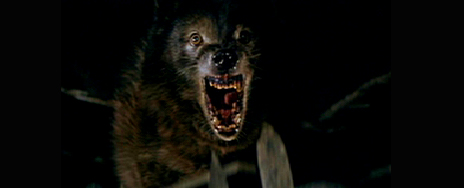
Wolfen is basically a movie about people menaced by unseen killers, but it's directed so excitingly, so against the norm for its genre, that it puts the jitters back in basic shock scenes. They key factor is better written, more interesting characters. Wadleigh chooses his cast well. In his first dramatic film Gregory Hines is funny and believable. We care about him as much as we do the odd but solid-resourceful wolf expert played by Tom Noonan, who manages to be weird and lovable at the same time. Diane Venora's Rebecca is a classy sidekick in the traditional sense, in that she's mainly there to illuminate Finney's Dewey Wilson character. No horror film ever had a better group of monster-hunters. When these people have their hearts in their throat, so do we. The dialogue script makes exposition into poetry and keeps all reactions in character -- there isn't a single, "Let's get out of here!" in the whole show. Finney brings his highly intelligent presence to the mix -- he's interesting even when just staring in close-up, watching an autopsy in progress. One of the best scenes in an abandoned church sees our hero retreating in a near panic after only an inkling that something dangerous is inside. It's so refreshing we want to applaud. It's the antithesis of Ridley Scott's Alien, in which victims who know horrible things are happening all around them repeatedly loiter in the dark like monster bait, giving the alien time to check its email before attacking.

Specially noted at the time were horror sequences stylized with what the filmmakers dubbed 'Alienvision', rapid floating POV shots suggesting the ghostly vision of the super wolves. When an authentic but costly heat-signature visual effect wasn't exciting enough, another optical company was employed to concoct a solarlized look. The shots themselves were done with the new Steadicam rig, producing exciting smooth camera moves. 35 years of overuse in horror pix later, the effect may not be as strong as it once was. We're told that the extra cost of these images is one of the things that got Wadleigh into trouble, but I would think that Orion's main problem was the stress on the monsters' political dimension, as opposed to generic horror thrills.
The Steadicam sees other uses as well, especially when Edward James Olmos strips down and does his wolf-prowl at the water's edge; the swoooping camera moves link him to the wolves that he calls spiritual kin. When Olmost and his native American friends work atop one of New York's bridges, Wadleigh appears to use a Louma Crane, showing Albert Finney's precarious position as he scales a suspension cable. None of this fancy-dance camerawork is ostentatious. The slick technique never breaks the narrative spell.
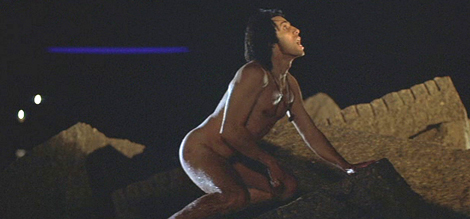
Many horror pictures have interesting sound mixes but we can feel this audio track getting to us, without the battering-ram approach of The Exorcist. James Horner was given twelve days to fashion a replacement score after another composer's work was deemed too spacey for Orion. Whenever the screen smash-cuts to another Alienvision POV, a distorted heavy whoosh sound hits us. Several years later, trailer makers adapted this 'bam-whoosh' effect to give their trailers extra punch. A certain stratum of brain-dead trailers has for years now used skull-thumping 'bam-woosh' punctuation on every &%^#%$ cut. You'll recognize it when you hear it.
At one point Wadleigh cuts to a nighttime view through some South Bronx ruins, and only after looking at the shot for a second do we realize that two beady red glowing eyes are staring back at us. It yields a nice little jolt. We're told that all the close-ups of snarling wolves were added in re-shoots. They're impressive and scary -- the wolves really mean business. 1 The message given is a non-message: we nature-ravaging philistines don't know nothin'. Meanwhile, the movie works up quality scares and basically succeeds like a house afire. It's just that fighting monsters and pondering the guilty evils of Anglo civilization excite different, unconnected parts of my guilty Anglo brain.
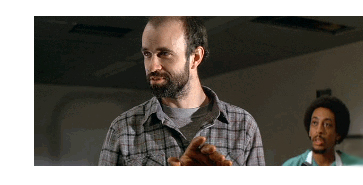
We'll never know if Wadleigh's cut of Wolfen would have succeeded as a horror-genre gauntlet thrown at the foot of arrogant white civilization. Did audiences ever take 'nature attacks' movies seriously? Alfred Hitchcock's unique horror epic is a fantastic blend of Antonioni abstraction, in which the birds seem an expression of the human complacency/anxiety crisis. The '70s overflowed with bogus ecological monsters taking revenge for man's neglect and pollution of the environment. Streiber and Wadleigh elect to put Wolfen's horrors in the context of terrorist payback, political chickens come to roost, etc.. This association has picked up more juice since 9/11, mainly because Wolfen features so many shots of the World Trade Center's twin towers.
One has to hand Wadleigh the prize for artistic integrity, as this is ambitious filmmaking of the shoot-yourself-in-the-foot variety - it's almost axiomatic that quality movies preaching uncomfortable truths die horrible box office deaths. The public usually wants more mythomaniacal trash like Rocky. I respond to this show positively, even though I have a heavy resistance to political messages with my horror thrills. Wolfen is a great sales job, and not only am I entertained, I almost buy the message. 2
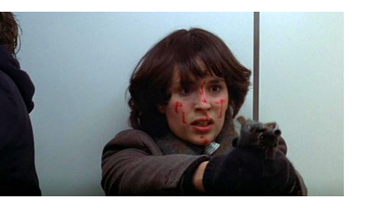
The Warner Archive Collection Blu-ray of Wolfen is a handsome and rich HD transfer of this horror thriller, which happily has held up quite well. All of the effects, particularly the gore effects, haven't dated; they seem as tasty (or tastefully rendered) as they did back in '81. The sets, particularly the large-scale exterior settings, are impressively lit. The whole show gives off the feeling that its technical crew was inspired by a creative director.
An audio process called 'MegaSound' was used for Wolfen, at least in its 6-track 70mm engagements. If this 'high impact audio presentation' was indeed similar to the old Sensurround system, it would use a cue track to trigger special low-end speakers to add a physical sensation to certain noises and 'presences.' It's no joke; owners of the first Wolfen laserdisc say that its soundtrack retained some of MegaSound's oomph. The track certainly is dynamic -- even at low volume those Alienvision scenes make us jump every time. James Horner's music goes for eerie tones during the mystical scenes but also uses grinding action cues here and there to remind us that something shocking is always around the corner. Some of these tracks sound almost identical to Horner's action music in Aliens five years later. I'm told that a couple of cues were recycled from his score for The Hand.
The disc's one extra is an original trailer. This show could really use a making-of documentary. A good article on it is at a site called The Gull Cottage/Sandlot.
Thanks to Wayne Schmidt for help with this review.

On a scale of Excellent, Good, Fair, and Poor,
Wolfen Blu-ray rates:
Movie: Very Good
Video: Excellent
Sound: Very Good - Excellent
Supplements: Original trailer
Deaf and Hearing Impaired Friendly?
YES; Subtitles: English
Packaging: Keep case
Reviewed: May 22, 2015
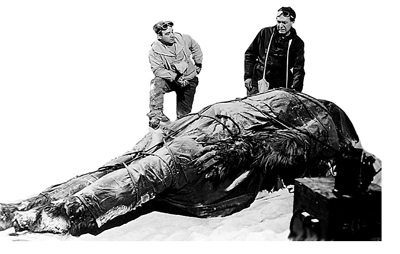
Footnotes:
1. Wolfen can disappoint horror fans hoping for something more outlandish -- the realistic treatment and the politico-fantasy subject matter do not naturally mix: "if they're just wolves, then shoot them." It can be off-putting, that just when the film has succeeded with the tough sell, convincing us that the wolves are a real menace, we're given evidence that they are supernatural after all. One actually dissolves away like a phantom. If the Wolfen have that kind of super-power, the concept has problems. How come they haven't taken over ages ago? And why isn't the film telling us to burn our houses, live in tents and worship the life spirit in every living thing, like good pantheists?
Return
2. Spolier-rama here, beware: Consider the similarities between Wolfen and the old Hammer/Nigel Kneale/Val Guest sci-fi classic The Abominable Snowman (of the Himalayas). In that show a savage-looking but reportedly superhuman race of aliens is camped out in the high mountains; they employ telepathic powers to communicate with a holy man, the High Lhama. The aliens as well as the monks are pacifists who no longer believe in violent human nature; the monks wait in seclusion and the aliens in hiding, presumably until humanity destroys itself, as in James Hilton's flawed colonial fantasy Lost Horizon. The alien snowmen can also use their telepathy as a mind control weapon against any humans that discover their existence. At the finish it appears (in one interpretation) that our hero Peter Cushing has been brainwashed into forgetting he's seen the monsters. The High hLama is probably a willing confederate of the aliens. The concept isn't very flattering to Eastern religion, making the Lhama a pawn of outer space creatures.
We're not sure exactly what 'powers' the Wolfen have. Edward James Olmos and his friends worship the Wolfen as their brothers in near-extermination. Olmos' Eddie Holt talks about shape-shifting, but he's really only role-playing to commune with the wolf spirits. He's a monster fellow-traveler, not a monster enabler as is the Lhama. Like the Lhama, he knows of the threat and aligns himself with it, against us.
The Yeti and the wolves have similar mental powers. Are some victims zapped by wolf telepathy? We see one wolf with eyes that appear to sparkle (it may be an effect of Alienvision). It's confusing because we have to work backwards from what the wolves must do to avoid detection. They're supposed to be everywhere, picking off luckless hoboes, 'people who won't be missed.' They're so smart that they pick and choose what internal organs to eat. They purposely target a land developer, and spare Dewey when he smashes a model of the proposed Bronx development.
So what Wolfen really means is a different form of NIMBY. Get too cynical about this, and one might wonder why the wolves haven't taken over the world. The part about the wolves being gods is way past the boundary of suspenseful bloody murder horror entertainment. That heady of a concept needs exceptionally special handling. Since this is reportedly exactly what Whitley Strieber's book was about, Orion wasn't complaining but instead decided against wholly political monsters. I wonder if Michael Wadleigh's original cut dealt with it in any more detail.
When producer Rupert Hitzig decided to become a director, I took a month away from trailer work at The Cannon Group to edit a horror film he made at the Culver Studios. We didn't discuss Wolfen at all.
Return
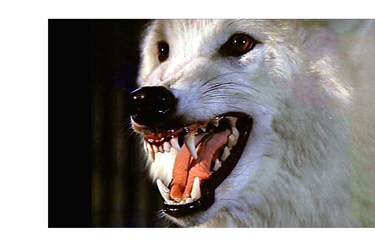
3. A note from correspondent Ray Morton, author of The Making of Close Encounters of the Third Kind, 6.01.15:
Hi Glenn, Really enjoyed your review of Wolfen. I had my own encounter with them not long after -- in 1983 I worked for a summer as an intern at Kaufman Astoria Studios. One of my assignments was to clear out an overcrowded store room. I walked down a very long, very creepy disused hallway to the storeroom, pulled open the door, and came face to face with one of the animatronic wolfen -- fangs bared and eyes glaring. It apparently had just been shoved in the closet when the movie was done and forgotten about. Thinking I was just going to clear out some old boxes of papers, I obviously wasn't expecting to see anything like that and it cared the living...daylights...out of me -- I let out a small yell, jumped back, and almost fell over myself trying to get away from it. Later I wheeled it out and put a funny hat on it and let it keep me company while I dealt with the rest of the storeroom's contents, which were just old papers and boxes and such. I think today the Wolfen is on display at the Museum of the Moving Image at Kaufman Astoria Studios. Hope you are well, Ray Morton

Text © Copyright 2015 Glenn Erickson
See more exclusive reviews on the Savant Main Page.
Reviews on the Savant main site have additional credits information and are often updated and annotated with reader input and graphics.
T'was Ever Thus.
Return to Top of Page
|


